Abstract
Objectives:
Children who use cochlear implants (CIs) have characteristic pitch processing deficits leading to impairments in music perception and in understanding emotional intention in spoken language. Music training for normal-hearing children has previously been shown to benefit perception of emotional prosody. The purpose of the present study was to assess whether deaf children who use CIs obtain similar benefits from music training. We hypothesized that music training would lead to gains in auditory processing and that these gains would transfer to emotional speech prosody perception.
Design:
Study participants were 18 child CI users (ages 6 to 15). Participants received either 6 months of music training (i.e., individualized piano lessons) or 6 months of visual art training (i.e., individualized painting lessons). Measures of music perception and emotional speech prosody perception were obtained pre-, mid-, and post-training. The Montreal Battery for Evaluation of Musical Abilities was used to measure five different aspects of music perception (scale, contour, interval, rhythm, and incidental memory). The emotional speech prosody task required participants to identify the emotional intention of a semantically neutral sentence under audio-only and audiovisual conditions.
Results:
Music training led to improved performance on tasks requiring the discrimination of melodic contour and rhythm, as well as incidental memory for melodies. These improvements were predominantly found from mid- to post-training. Critically, music training also improved emotional speech prosody perception. Music training was most advantageous in audio-only conditions. Art training did not lead to the same improvements.
Conclusions:
Music training can lead to improvements in perception of music and emotional speech prosody, and thus may be an effective supplementary technique for supporting auditory rehabilitation following cochlear implantation.
Keywords: Children, Cochlear implants, Emotional speech prosody, Music perception, Music training
INTRODUCTION
The purpose of the present study was to investigate whether music training can improve hearing in children who are deaf and use cochlear implants (CIs) to hear. We expected that music training would have direct benefits on tasks that are difficult for children with CIs, including music perception and discrimination of emotion in speech. These improvements were expected based on known benefits of music training on listening in normal-hearing children (NH) (Thompson et al. 2004).
Cochlear Implantation in Children
Increasingly, children with congenital deafness are being provided with auditory prostheses known as CIs. A CI differs from a hearing aid in that it does not amplify sound and does not rely on a functioning middle or inner ear. The implant contains an array of electrodes, which is surgically implanted into the scala tympani of the inner ear (cochlea). The electrodes deliver electrical pulses to directly stimulate the auditory nerve, bypassing the outer and middle ear. CIs support many aspects of auditory perception, allowing children to develop spoken language (Svirsky et al. 2000); however, CIs provide limited sensitivity to pitch and spectral attributes of music (see McDermott 2004 for a review), as well as the emotional aspects of spoken language (Nakata et al. 2012).
Music Perception Is Impaired Through a CI
CIs provide inadequate representation of fine-temporal structure, which limits sensitivity to important characteristics of music including pitch and timbre (Limb & Roy 2014). Empirical assessments of music perception in adult CI users have found that while perception of rhythm approaches levels of accuracy comparable to NH population, perception of pitch is particularly impaired (McDermott 2004; Galvin, Fu, & Nogaki 2007; Gfeller et al. 2007; Cooper et al. 2008). Given the importance of pitch in music, it is not surprising that many adults using CIs report low levels of music appreciation after implantation (Mirza et al. 2003; but see Fuller et al. 2013).
Child CI users experience many of the deficits in auditory processing found in adult CI users. Empirical assessments of music perception have found that child CI users demonstrate stronger perception of rhythm compared with perception of pitch. Children using CIs seem to focus on rhythm rather than pitch when processing musical information (Vongpaisal et al. 2006, 2009). Studies imply that although child CI users can use tempo and rhythm cues to judge music, overall perception of music is impaired relative to NH children, particularly with regards to pitch processing (Nakata et al. 2006; Vongpaisal et al. 2006, 2009; Xu et al. 2009; Hopyan et al. 2012). However, unlike their adult counterparts, many children using CIs tend to give favorable appraisals to music (Nakata et al. 2005; Mitani et al. 2007; Trehub et al. 2009), and a substantial number of them are involved in musical activities, including singing, dancing, and learning an instrument (Gfeller et al. 1999).
Perception of Emotional Prosody Is Impaired Through a CI
Although children using CIs perform similarly to NH controls when identifying a target emotion using visual cues, they have been shown to have difficulty when using only auditory cues (Hopyan-Misakyan et al. 2009). These difficulties may stem in part from difficulties with pitch processing (Scherer 1995, 2003). To demonstrate this difficulty, consider the difference between sadness and fear. Although both emotions are negative in affect the latter is characterized by higher pitch and greater pitch variability. These acoustic changes are relatively invariant arising from arousal-dependent changes in tension of the laryngeal muscles (Frick 1985).
Research by Wiefferink et al. (2012) suggests that the emotion identification issues in deaf children may extend to social functioning. Across a variety of contexts, children with CIs are less proficient in emotion regulation and social competence than NH controls. The inability to perceive, understand, and regulate emotions puts children with CIs at risk for poor social interactions, which in turn, may impact quality of life (Schorr et al. 2009).
Benefits of Music Training in NH Individuals
Emotional prosody, like music, is perceived by tracking variations in pitch, intensity, and timbre (Scherer 1995). Given that the processing of these features typically benefit from music training, one might expect that skills from music training will transfer to the perception of emotional prosody. Prior work with NH individuals has demonstrated evidence for auditory benefits of music training. In particular, skills obtained through music training seem to transfer to perception of emotional speech prosody (Nashkoff 2007). Thompson et al. (2004) found that musically trained adults performed better than musically untrained adults in the identification of emotion in semantically neutral speech. In a follow-up study, NH children were randomly assigned to receive 1 year of lessons in singing, keyboard, or drama. The keyboard group and drama group both appeared to benefit with regard to emotional speech prosody, but surprisingly, the singing group showed no gains. The authors consider various possibilities for the difference in the efficacy between keyboard and singing lessons but it appears likely that the implementation of training may have differed with respect to rigor.
Benefits of Auditory Training in Individuals With CIs
Active auditory training has been shown to confer benefits on auditory perception in individuals using CIs (Fu & Galvin 2007; Galvin et al. 2007, 2012; Krull et al. 2012). Importantly, training programs, such as speech training, have been shown to improve perceptual access to tonal and pitch cues in CI users (Fu & Galvin 2007; Galvin et al. 2007; Wu et al. 2007). Benefits have also been reported for perception of emotional prosody, albeit in normal hearing adults listening to CI simulations (Krull et al. 2012).
Music training may be an effective form of auditory training. Studies involving adult CI users have shown that music training can lead to improvements in various aspects of music perception, including timbre recognition (Gfeller et al. 2002), melody recognition (Gfeller et al. 2000), rhythmic perception (Peterson et al. 2012), and melodic contour (Galvin et al. 2007; Peterson et al. 2012). Furthermore, Lo et al. (2015) found evidence that training in melodic contour discrimination improves elements of speech perception, including intonation.
However, few of these studies explored the generalization of music training to emotional prosody perception. In a study with adult CI users, Peterson et al. (2012) randomly assigned participants to music training or art training. Those in the music program showed greater overall improvements in perception of timbre, melodic contour, and rhythm. With regards to emotional prosody, both groups improved significantly; however, all participants were tested 3 months or less after implantation, leaving open the possibility that the gains in performance were due to ongoing experience with the CI rather than training.
Although the possible benefits of music training for child CI users are not as well documented as in adult CI users, quasi-experimental and correlational studies have demonstrated a positive influence of music training on music perception in children using CIs (Yucel et al. 2009; Chen et al. 2010; Fu et al. 2015). For example, Chen et al. (2010) report that musically trained child CI users are better at discriminating pitch direction than those who are musically untrained. Furthermore, the duration of music training is positively correlated with accuracy of pitch perception.
Because music training appears to be able to improve aspects of music perception in child CI users, it is possible that music training may also improve perception of emotional prosody, which relies strongly on pitch cues. Several studies have found generalized benefits for music training in child CI users, including improved auditory scene analysis, auditory working memory, and phonetic discrimination (Yucel et al. 2009; Rochette et al. 2014; Torppa et al. 2014). However, experimental research on the generalization effects of music training to emotional prosody is nonexistent in the child CI population.
Present Study
The potential benefits of music training for child CI users are currently not well understood. In the present study, we investigated whether music perception in children using CIs would improve as a function of music training. Given the importance of pitch, timbre, and intensity cues to both music and emotional prosody perception, we expected that the music training might generalize to improved emotional prosody perception. As a control for our music training intervention, we provided visual art training to a control group of child CI users. Both types of training could be described as art-based, and involved individualized instruction and feedback provided by an instructor. Demographic factors, such as age at testing, age at implantation, and CI experience, were compared with music and emotional prosody performance before and after training.
MATERIALS AND METHODS
The experimental protocol was independently reviewed and approved by the Research Ethics Boards at Ryerson University (2010129) and the Research Ethics Board at Sick Children’s Hospital (1000022882).
Participants
Participants consisted of child and adolescent CI users (age 6 to 15 years, M = 10.22, SD = 2.8). All participants were recruited through the Cochlear Implant Department at the Hospital for Sick Children in Toronto, Canada. A total of 25 participants were recruited to participate in the study. All participants were enrolled in school programs that utilized oral communication as the primary means of instruction. Music and art training took place in two geographic locations in the greater Toronto area. Before training, participants had no knowledge of the type of training that would take place at each location. To encourage participation, assignment to the music or art group was pseudorandom taking into account preference for the location of training. For the minority of participants (6) without a location preference, the group assignment was fully randomized. Seven of the 25 participants dropped out of the study before completion due to the inability to commit to training. This resulted in a total of 9 participants in each training group. Table 1 provides individual background information encompassing demographic and auditory data for all participants who completed the study.
TABLE 1.
Individual participant demographics for music and art training condition
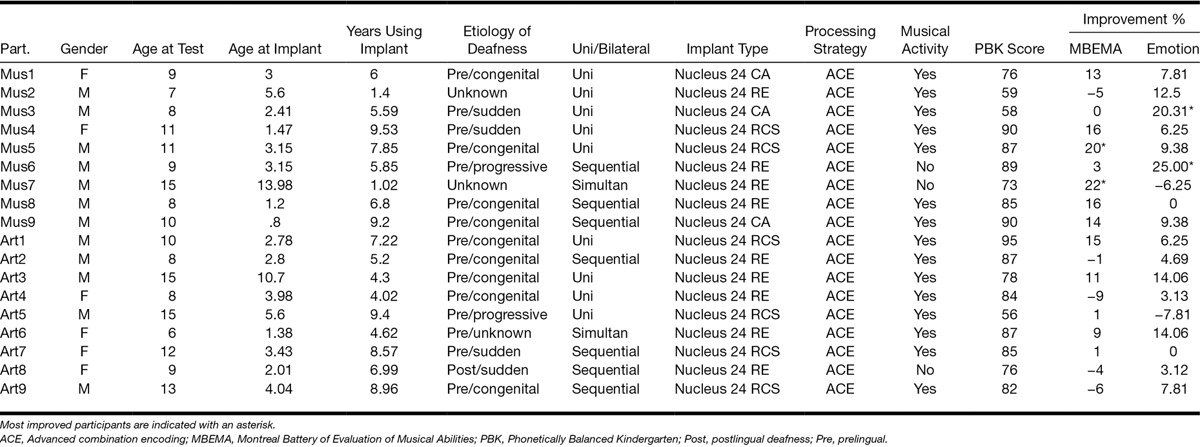
No significant differences were found between groups with respect to age at testing, age at implantation, and CI experience. In addition, children did not differ with regard to speech perception skills as assessed by the Phonetically Balanced Kindergarten word list, an open-set, spoken word repetition task (Haskins 1949).
The majority of participants—7 participants in the music group and 8 participants in the art group—reported involvement in informal musical activities outside of the training program. Activities reported were primarily school-based, such as classroom singing.
Instruments
Evaluation of Musical Abilities
The Montreal Battery for Evaluation of Amusia (MBEA) was originally designed to diagnose impairments in music processing and amusia in particular (Peretz et al. 2003). Nonetheless, the MBEA has been used to assess music perception abilities in individuals using CIs (Cooper et al. 2008; Hopyan et al. 2012). More recently, a children’s version of the MBEA, the Montreal Battery for Evaluation of Musical Abilities (MBEMA), has been developed. It consists of five subtests that evaluate different elements of music perception (Peretz et al. 2013): scale, contour, interval, rhythm, and incidental memory. Each subtest contains 2 practice trials involving feedback, followed by 20 trials of testing without feedback. In the three subtests involving pitch perception, and the subtest involving rhythm perception, participants are asked to listen to a standard and comparison melody and to indicate whether melodies are “same” or “different” (50% of trials are “different”). In the “different” trials of the pitch perception subtests, a single note changes from in-key to out-of-key (scale), or an in-key note changes in pitch direction (contour), or an in-key note changes in pitch interval while maintaining pitch direction (interval). In the “different” trials of the rhythm subtest, the durations of two adjacent notes are changed to alter the rhythmic grouping of notes (50% of trials are “different”). In the subtest involving incidental memory, participants are asked to provide a “yes” or “no” answer for whether they heard the melody during the previous subtests (50% of trials are novel).
Measure of Perceived Emotional Prosody
To measure perceived emotional prosody, a series of audiovisual recordings were created. The recordings consisted of 2 children (1 male and 1 female) and 2 adults (1 male and 1 female) speaking an emotionally neutral sentence in a manner that conveyed one of four emotions: happy, sad, angry, or fearful. Each emotion was presented at two levels of emotional expressivity: low emotional expression and high emotional expression. The text for the sentence was drawn from the Diagnostic Analysis of Nonverbal Accuracy Scale developed by Nowicki and Duke (1994), “I am going out of the room right now, but I’ll be back later.” Participants were asked to assess the emotion conveyed in each trial under audio-only (voice only) and audiovisual (voice and facial features) presentation conditions. Trials were blocked with respect to age (child or adult speaker) and the modality of presentation (audio or audiovisual). Each block contained 16 trials for a total of 60 trials. Blocks were presented in a randomized sequence to control for any order effects.
Procedure
All children were invited to an information session and were given information about the importance of the longitudinal commitment. Participating families were told that we were assessing whether art-based training would lead to various cognitive benefits including auditory perception. Lessons were provided at no expense to families.
Music lessons consisted of training on the piano. Each lesson involved two sequential segments. One segment of the lesson was dedicated to music theory rudiments and technical exercises, including scales, bilateral finger control, and hand positions. The second segment of the lesson was dedicated to learning a song, from the Faber and Faber “Favorites” edition for beginners (2001). Students were also encouraged to rehearse songs vocally. Art lessons consisted of training in painting. Each lesson contained two segments. One segment of the lesson was dedicated to painting rudiments, including color theory, brush techniques, texturizing, perspective, and anatomy. The second segment of the lesson was dedicated to generating paintings.
Participants attended one private half-hour lesson per week for a total of 24 lessons. All music students had access to a keyboard and were expected to practice 2 times a week for 30 minutes. The same amount of practice was expected for the art students. If a participant was absent during a class, they were required to make up for the missed lesson so that all participants received the same amount of instruction. The participants completed testing at three times: pretraining, midtraining (after the 12th lesson), and post-training (after the 24th lesson). All testing took place in a sound proof booth located at the Hospital for Sick Children. All test stimuli were presented from a laptop computer through external speakers at a listening level that was calibrated to range between 60 and 65 dBA. The order of the measures was randomized. Each testing session took approximately 1 hr to complete.
RESULTS
The alpha level for all tests was set to 0.05. Bonferroni adjustments were used for all analyses involving multiple comparisons.
The Montreal Battery for Evaluation of Musical Abilities
Figures 1 and 2 displays the mean percentage of MBEMA scores at pre-, mid-, and post-training for each subtest for music and art groups respectively. All MBEMA scores were entered into a mixed-design analysis of variance with group as the between-subjects factor (music training and art training) and time (pre-, mid-, and post-training) and subtest (scale, contour, interval, rhythm, memory) as within-subjects factors. The analysis revealed a main effect of Time [F(2,32) = 7.4, p = 0.002], a marginal main effect of subtest [F(4,64) = 2.134, p = 0.087], and an interaction between time and group [F(2,32) = 3.66, p = 0.037]. A series of within group, planned contrasts were conducted to further investigate these main effects and interactions.
Fig. 1.
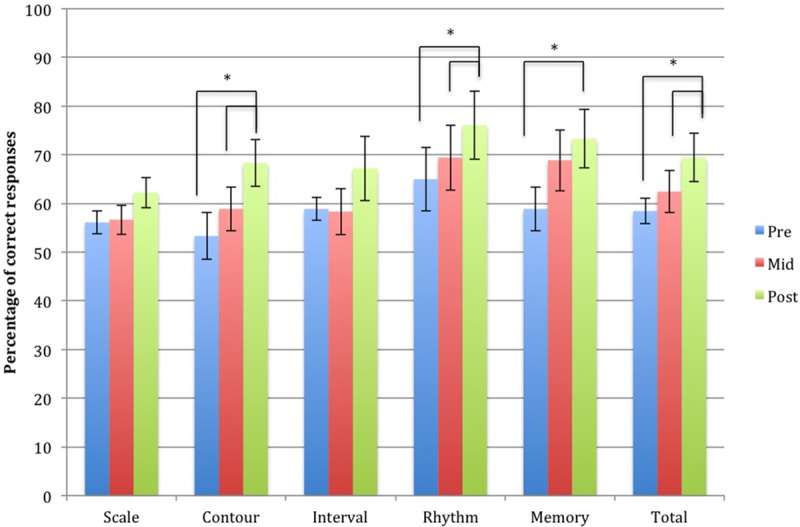
Mean percent correct scores for the music training group for the MBEMA subtests as a function of test session (pre-, mid-, and post-training). The error bars show the standard error. *Significant differences (p < 0.05). MBEMA, Montreal Battery of Evaluation of Musical Abilities.
Fig. 2.
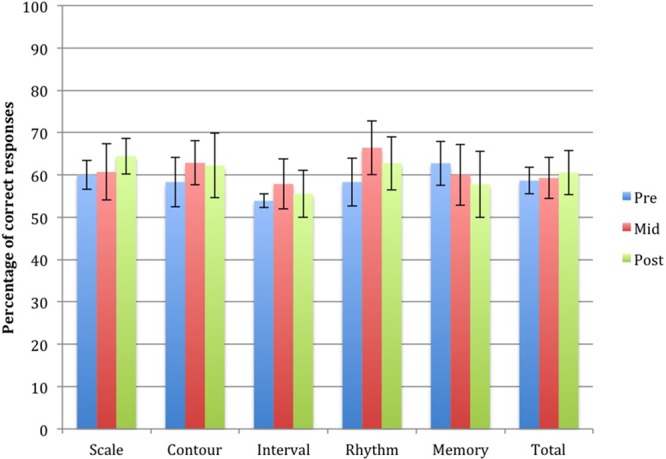
Mean percent correct scores for the art training group for the MBEMA subtests as a function of test session (pre-, mid-, and post- training). The error bars show the SE. MBEMA, Montreal Battery of Evaluation of Musical Abilities.
A main effect of time was found in the music group [F(2,16) = 9.66, p = 0.002] but not in the art group [F(2,16) = 0.37, p = 0.7]. In particular, pairwise comparisons in the music group revealed improvements between mid- and post-training (p = 0.003), but no improvements from pre- and midtraining (p = 0.161). We next assessed performance of the music group on each of the five subtests of the MBEMA. No effect of time was found for the scale subtest [F(2,16) = 2.26, p = 0.137]. A marginally significant main effect of time was found for the interval subtest [F(2,16) = 3.19, p = 0.068]. Significant effects of time were found for contour [F(2,16) = 4.08, p = 0.037], rhythm [F(2,16) = 5.722, p = 0.03], and memory [F(2,16) = 4.01, p = 0.04] subtests.
Emotional Prosody Perception
To determine if accuracy scores on the emotional prosody perception task improved over time, the percentage of correct responses was entered into a mixed-design analysis of variance with group (music versus art) as the between-subjects factor and time (pre-, mid-, post-training) and modality (audiovisual versus audio only) as within-subjects factors. The analysis revealed a main effect of time [F(2,32) = 8.72, p = 0.001] and modality [F(1,16) = 91.33, p < 0.001]. Overall, children were more accurate after training (M = 64.8%, SE = 2.1) than before training (M = 57.6%, SE = 2.4) and for audiovisual stimuli (M = 71.1%, SE = 2.1) than for audio-only stimuli (M = 52.2%, SE = 2.2). No interactions were found for time by group [F(2,16) = 0.78, p = 0.47), modality by group [F(1,16) = 0.005, p = 0.94), or time by modality by group [F(2,32) = 1.61, p = 0.22]. A series of within group, planned comparisons were conducted to further investigate the main effects.
A main effect of time was found for the music group [F(2,15) = 5.6, p = 0.015] but not for the art group [F(2,15) = 1.58, p = 0.24]. In particular, differences in the music group were found between pre- and post-training (p = 0.004), with significant improvements between pre- and midtraining (p = 0.047) and marginal improvements between mid- and post-training (p = 0.08).
Next, we analyzed the percentage of correct responses for audiovisual and audio-only trials. See Figures 3 and 4 for group percentages at pre-, mid-, and post-training for audiovisual and audio-only trials respectively. For audiovisual trials, marginally significant improvements were found for the music group [F(2,15) = 3.258, p = 0.067] but the art group yielded no improvements [F(2,15) = 1.705, p = 0.215]. In particular, differences in the music group occurred between pre- and midtraining (p = 0.04), but not between mid- and post-training (p = 0.77). For audio-only trials, improvements were found for the music group [F(2,15) = 4.273, p = 0.034], but not for the art group [F(2,15) = 1.22, p = 0.322]. The differences in the music group occurred between mid- and post-training (p = 0.038), but not between pre- and midtraining (p = 0.14).
Fig. 3.
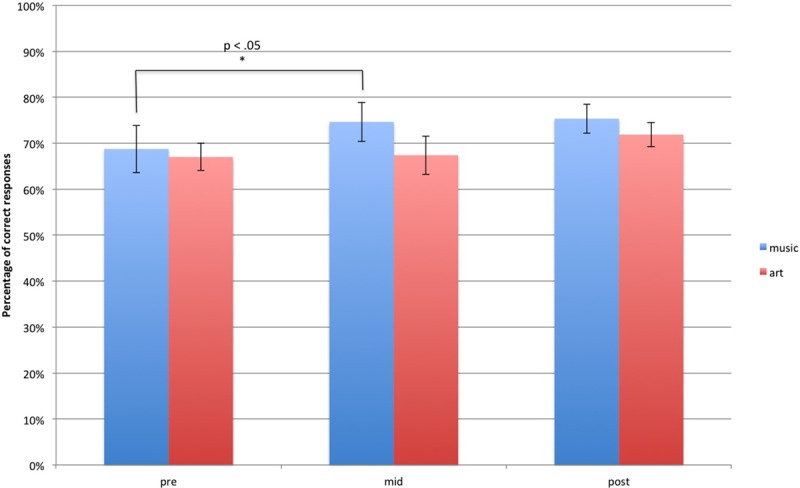
Mean percent correct scores for the music and art training groups for emotional prosody perception with audiovisual presentation, as a function of test session (pre-, mid-, and post- training). The error bars show the SE. *Significant differences (p < 0.05).
Fig. 4.
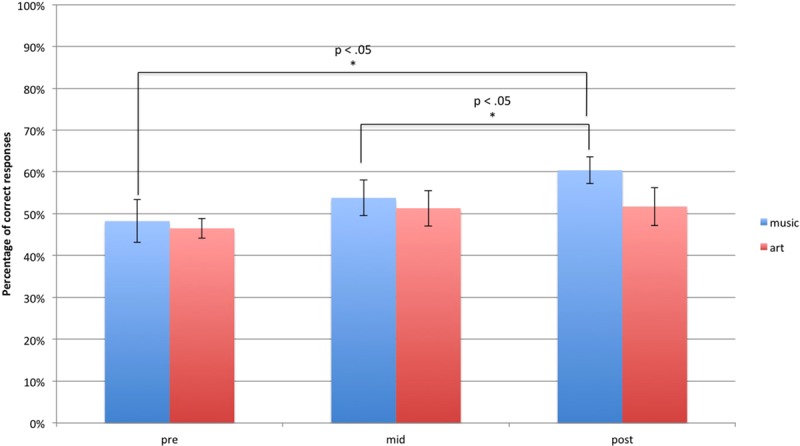
Mean percent correct scores for the music and art training groups for emotional prosody perception with audio-only presentation, as a function of test session (pre-, mid-, and post- training). The error bars show the SE. *Significant differences (p < 0.05).
Correlations With Demographic Variables
Baseline
See Table 2 for all baseline correlations. Pretraining performance on the MBEMA did not correlate with participants’ age at testing, age at implantation, and CI experience. In addition, no differences were found in pretraining scores between unilateral and bilateral users (t(16) < 1, p = 0.762). Pretraining MBEMA scores did not differ between music (M = 58.44, SD = 7.8) and art groups (M = 58.67, SD = 9.28), (t(16) = 0.055, p = 0.96).
TABLE 2.
Correlation between demographic variables and initial perceptual scores
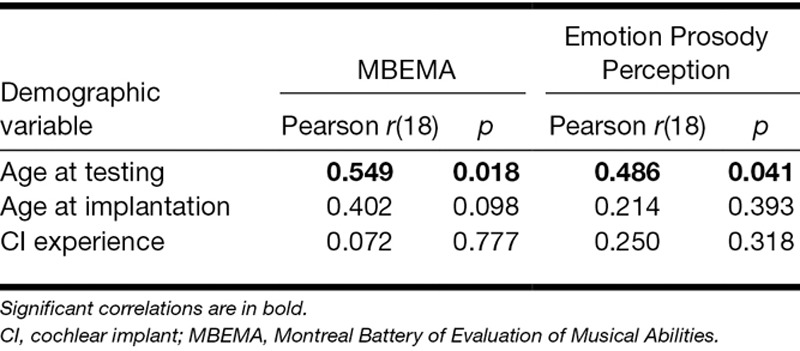
Pretraining performance on the emotional prosody perception task did not correlate with participants’ age at testing, age at implantation, and CI experience. In addition, no differences were found in pretraining scores between unilateral users and bilateral users (t(16) = 1.3, p = 0.213). Pretraining emotional prosody perception scores did not differ between music (M = 56.77, SD = 6.5) and art groups (M = 58.51, SD = 12.72), (t(16) = 0.365, p = 0.722).
Improvements
See Table 3 for all improvement score correlations. Improvement on the MBEMA did not correlate with participants’ age at testing, age at implantation, and CI experience. No differences were found between improvement scores in unilateral users and bilateral users (t(16) = 0.188, p = 0.85). Furthermore, the two most improved individuals (Mus5 and Mus7) were dissimilar in the range of demographic variables assessed.
TABLE 3.
Correlation between demographic variables and improvement scores
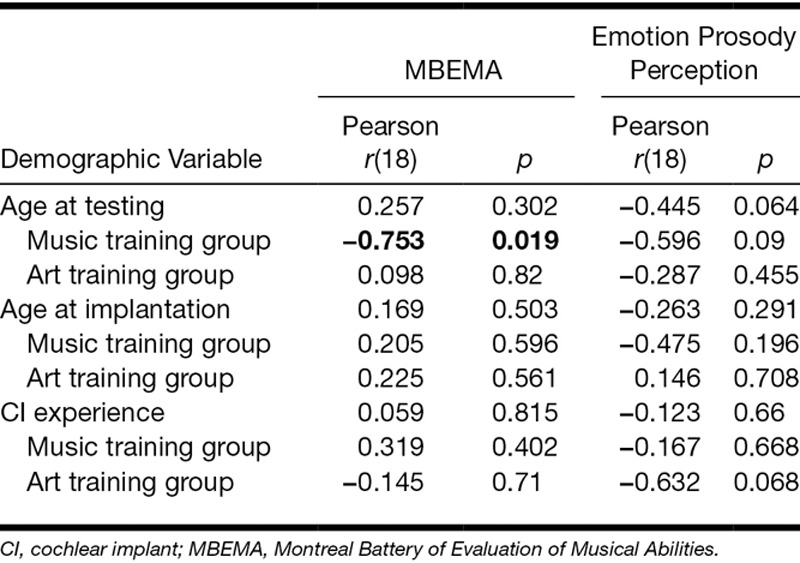
Improvement on the emotional prosody perception did not correlate with participants’ age at testing, age at implantation, and CI experience. No differences were found between improvement scores in unilateral users and bilateral users (t(16) = 1.47, p = 0.162). Notably, the two most improved individuals (Mus8 and Mus14) both had relatively early age of implantation (2.41 and 3.15 years, respectively). Furthermore, both participants had been using their CI for more than 5 years.
DISCUSSION
Eighteen children using CIs were randomly assigned to receive music training or art training for a period of 6 months. Those children who received music training experienced improvements in certain aspects of music perception and in perception of emotional speech prosody. These auditory improvements were predominantly found from mid- to post-training. There was no significant improvement for any of the outcome measures for the visual art training group. While the improvements in music perception corroborate findings of previous music training studies (Gfeller et al., 2000, 2002; Galvin et al. 2007; Yucel et al. 2009; Peterson et al. 2012; Fu et al. 2015), the finding regarding improvement in perception of emotional speech prosody is novel and potentially important to auditory rehabilitation in this population.
Perception of Music Before and After Training
For the art group, we observed that overall scores on the MBEMA did not improve as a function of training. For the music group, we observed that scores in the contour and interval subtests improved, while scores in the scale test remained unchanged. This differential pattern of improvement is not surprising given that the scale test requires participants to detect out-of-key notes, which requires an internalized representation of the structural hierarchy of tones in a scale. This task is particularly difficult for individuals using CIs given their impoverished access to pitch. Furthermore, a participant would experience a handicap in the scale test if they were not able to distinguish between notes that are only one semitone apart (i.e., in scale versus out of scale). A short period of training does not seem enough to overcome the limitations of a CI that compromise such fine pitch discriminations.
Previous studies have found that children using CIs are sensitive to rhythm (Vongpaisal et al. 2006, 2009). Indeed, children with CIs show smaller deficits in rhythm perception than in pitch perception (Hopyan-Misakyan et al. 2009). Nonetheless, consistent with Peterson et al. (2012), we found that music training improved accuracy in rhythm perception. However, art training did not improve accuracy in rhythm perception.
The present study found that music training improved accuracy in incidental memory. This observed improvement is consistent with findings reported by Gfeller et al. (2000). This particular improvement may depend heavily on rhythm perception. Indeed Vongpaisal et al. (2006, 2009) have shown that children with CIs rely on rhythm in song recognition tasks. Because rhythm perception also improved following music training, this may have contributed to improvements in incidental memory seen in the music group. Art training did not improve accuracy in incidental memory.
Perception of Emotional Prosody Before and After Training
While previous research with NH children has shown that the benefits of music training can transfer to the perception of emotional speech prosody (Thompson et al. 2004), this is the first study to show that music training can improve perception of emotional speech prosody in child CI users. This effect was particularly evident when facial features were not available to support emotion identification.
The advantage of music training was particularly apparent in audio-only trials. Given that individuals using CIs tend to rely on facial cues to understand the emotional intention of speech (Hopyan-Misakyan et al. 2009), it is not surprising that there were similar success rates between the art and music groups over time in the audiovisual trials. However, when facial cues were unavailable, individuals had to rely solely on auditory perception to determine the emotional intention. For this reason, the perceptual benefits of music training were most notable in the audio-only trials. There was minimal improvement in the art group for audio-only trials; thus, we can infer that the improvement of audio-only perception of emotional prosody is attributable to the effect of music training on core auditory processing. Furthermore, because the benefits of music training observed in this study were experimentally driven and could not be explained by the demographic composition of the two groups, we attribute the extra-musical benefits to music training.
Our results are somewhat inconsistent with a prior music training study conducted by Peterson et al. (2012), in which no evidence was found for extra-musical benefits due solely to music training. Several important differences exist between the two studies. First, Peterson et al. administered music training to adults while the present study administered training to children. Second, Peterson et al. used a population of “naïve” implant users (implanted within 1 year or less). Their research reported an improvement in the perception of emotional prosody in both music and control conditions. Previous research has demonstrated that the greatest gains in auditory perception occur within the first 3 months of CI usage (Spivak & Waltzman 1990). In contrast, the mean time since implantation in the present study was 5.9 years.
Most Notable Benefits Following 3 Months of Training
The benefits of music training on auditory perception were predominantly seen between the mid- and post-training testing sessions. Although previous research has demonstrated that adults using CIs can improve aspects of music perception after only 3 months of music training (Gfeller et al. 2000, 2002), the present study did not fully replicate those findings in children. While we did see a positive trend in overall music perception from pre- to midtraining, this improvement did not reach significance. This may have been due to our small sample size; however, more notable improvements of auditory perception (music perception and emotional prosody perception) were seen in the second half of the training period. This finding suggests that a longer training regimen may be optimal for this age group.
Contribution of Demographic Factors
With the exception of age at testing, demographic factors were not correlated with baseline scores on the music task or the emotional prosody perception task. Furthermore, the present study did not find any evidence that demographic factors were associated with the amount of improvements. In particular, unilateral versus bilateral implantation and age of implantation did not correlate with improvements seen on the tasks. This finding is consistent with other training studies in the literature (e.g., Chen et al. 2010; Fu et al. 2015; however, see Rochette et al. 2014), and provides additional evidence for the robust benefits of music training, regardless of the individual demographic factors.
Limitations and Conclusion
There are a few limitations of the present study that must be taken into account. First, assignment to group was not fully randomized. To encourage full participation, we allowed families to select from one of two training locations that determined the outcome of their group assignment. Second, although students were encouraged to practice twice a week, we did not record the amount of at-home practicing that took place in either group. Future studies should carefully track the amount of practice to determine the extent of practice that is necessary to yield gains in musical and extra-musical skills. We also acknowledge that there may have been a familiarity (test–retest) effect that led to marginal improvements in audiovisual emotional prosody perception in both training groups.
It would have been valuable to also include a long-term follow-up with participants. As it stands, we cannot be sure about whether the improvements observed in the study are short or long term. Future research should track music and extra-musical skills over a longer period of time to determine the extent to which these benefits may persist over time.
There are important social implications of the current findings. Children using CIs demonstrate difficulty in understanding emotion (Wiefferink et al. 2013), which puts them at risk for poor social interactions (Schorr et al. 2009). In addition to supporting music perception, the current results indicate that music training supports the perception of emotional prosody, which should contribute positively to quality of life. Given these benefits, music training should be considered as a useful supplement to current methods of auditory and speech training in children using CIs.
SHORT SUMMARY
The present study investigated whether music training would lead to gains in auditory perception in child cochlear implant users. Participants received 6 months of music training or visual art training. Dependent variables included measures of music perception and emotional speech prosody perception. Performance on these measures was obtained pre-, mid-, and post-training. Results showed that music training improved music perception and emotional prosody perception. These findings have important implications for auditory rehabilitation.
ACKNOWLEDGMENTS
We are indebted to Sina Fallah of the Centre for Music Education and Cognition for providing music lessons and Christopher Lachine for providing art lessons. We would also like to thank the participants and their families.
Footnotes
This research was funded by a fellowship from the Social Science and Humanities Research Council awarded to the first author, as well as a research chair funded by Sonova and a research grant from the Ontario Ministry of Research Innovation awarded to the last author.
The authors have no conflicts of interest to disclose.
REFERENCES
- Chen J. K., Chuang A. Y., McMahon C., et al. Music training improves pitch perception in prelingually deafened children with cochlear implants. Pediatrics, 2010. 125, e793–e800.. [DOI] [PubMed] [Google Scholar]
- Cooper W. B., Tobey E., Loizou P. C. Music perception by cochlear implant and normal hearing listeners as measured by the Montreal Battery for Evaluation of Amusia. Ear Hear, 2008. 29, 618–626.. [DOI] [PMC free article] [PubMed] [Google Scholar]
- Faber N., Faber R. Pretime Favorites: Primer level. 2001. Ann Arbor, MI: Faber Piano Adventures. [Google Scholar]
- Frick R. W. Communicating emotion: The role of prosodic features. Psychol Bulletin, 1985. 97, 412. [Google Scholar]
- Fu Q. J., Galvin J. J., 3rd Perceptual learning and auditory training in cochlear implant recipients. Trends Amplif, 2007. 11, 193–205.. [DOI] [PMC free article] [PubMed] [Google Scholar]
- Fu Q. J., Galvin J. J., 3rd, Wang X., et al. Benefits of music training in mandarin-speaking pediatric cochlear implant users. J Speech Lang Hear Res, 2015. 58, 163–169.. [DOI] [PMC free article] [PubMed] [Google Scholar]
- Fuller C., Mallinckrodt L., Maat B., et al. Music and quality of life in early-deafened late-implanted adult cochlear implant users. Otol Neurotol, 2013. 34, 1041–1047.. [DOI] [PubMed] [Google Scholar]
- Galvin J. J., 3rd, Fu Q. J., Nogaki G. Melodic contour identification by cochlear implant listeners. Ear Hear, 2007. 28, 302–319.. [DOI] [PMC free article] [PubMed] [Google Scholar]
- Gfeller K., Witt S. A., Spencer L. J., et al. Musical involvement and enjoyment of children who use cochlear implants. Volta Rev, 1999. 100, 213–233.. [Google Scholar]
- Gfeller K, Witt S., Stordahl J, et al. The effects of training on melody recognition and appraisal by adult cochlear implant recipients. J Acad, 2000. 33, 115–138.. [Google Scholar]
- Gfeller K., Witt S., Adamek M., et al. Effects of training on timbre recognition and appraisal by postlingually deafened cochlear implant recipients. J Am Acad Audiol, 2002. 13, 132–145.. [PubMed] [Google Scholar]
- Gfeller K., Turner C., Oleson J., et al. Accuracy of cochlear implant recipients on pitch perception, melody recognition, and speech reception in noise. Ear Hear, 2007. 28, 412–423.. [DOI] [PubMed] [Google Scholar]
- Haskins H. A phonetically balanced test of speech discrimination for children. 1949. Evanston, IL: Unpublished Master’s Thesis, Northwestern University. [Google Scholar]
- Hopyan-Misakyan T. M., Gordon K. A., Dennis M., et al. Recognition of affective speech prosody and facial affect in deaf children with unilateral right cochlear implants. Child Neuropsychol, 2009. 15, 136–146.. [DOI] [PubMed] [Google Scholar]
- Hopyan T., Peretz I., Chan L. P., et al. Children using cochlear implants capitalize on acoustical hearing for music perception. Front Psychol, 2012. 3, 425. [DOI] [PMC free article] [PubMed] [Google Scholar]
- Krull V., Luo X., Iler Kirk K. Talker-identification training using simulations of binaurally combined electric and acoustic hearing: generalization to speech and emotion recognition. J Acoust Soc Am, 2012. 131, 3069–3078.. [DOI] [PMC free article] [PubMed] [Google Scholar]
- Limb C. J., Roy A. T. Technological, biological, and acoustical constraints to music perception in cochlear implant users. Hear Res, 2014. 308, 13–26.. [DOI] [PubMed] [Google Scholar]
- Lo C. Y., McMahon C. M., Looi V., et al. Melodic contour training and its effect on speech in noise, consonant discrimination, and prosody perception for cochlear implant recipients. Behav Neurol, 2015. 2015, 352869. [DOI] [PMC free article] [PubMed] [Google Scholar]
- McDermott H. J. Music perception with cochlear implants: A review. Trends Amplif, 2004. 8, 49–82.. [DOI] [PMC free article] [PubMed] [Google Scholar]
- Mirza S., Douglas S. A., Lindsey P., et al. Appreciation of music in adult patients with cochlear implants: A patient questionnaire. Cochlear Implants Int, 2003. 4, 85–95.. [DOI] [PubMed] [Google Scholar]
- Mitani C., Nakata T., Trehub S. E., et al. Music recognition, music listening, and word recognition by deaf children with cochlear implants. Ear Hear, 2007. 28(2 Suppl), 29S–33S.. [DOI] [PubMed] [Google Scholar]
- Nakata T., Trehub S. E., Kanda Y. Effect of cochlear implants on children’s perception and production of speech prosody. J Acoust Soc Am, 2012. 131, 1307–1314.. [DOI] [PubMed] [Google Scholar]
- Nakata T., Trehub S. E., Mitani C., et al. Music recognition by Japanese children with cochlear implants. J Physiol Anthropol Appl Human Sci, 2005. 24, 29–32.. [DOI] [PubMed] [Google Scholar]
- Nakata N., Trehub S. E., Mitani C., et al. Pitch and timing in the songs of deaf children with cochlear implants. Music Percept, 2006. 24, 147–153.. [Google Scholar]
- Nashkoff K. The relationship between pitch discrimination skills and speech prosody decoding skills (Doctoral dissertation). Retrieved from ProQuest Dissertations and Theses database. (UMI No. 3251371).2007. [Google Scholar]
- Nowicki S., Jr, Duke M.P. Individual differences in the nonverbal communication of affect: The diagnostic analysis of nonverbal accuracy scale. J Nonverbal Behav, 1994. 18, 9–36.. [Google Scholar]
- Peretz I., Champod A. S., Hyde K. Varieties of musical disorders. The Montreal Battery of Evaluation of Amusia. Ann N Y Acad Sci, 2003. 999, 58–75.. [DOI] [PubMed] [Google Scholar]
- Peretz I., Gosselin N., Nan Y., et al. A novel tool for evaluating children’s musical abilities across age and culture. Front Syst Neurosci, 2013. 7, 30. [DOI] [PMC free article] [PubMed] [Google Scholar]
- Peterson B., Mortensen M. V., Hansen M., et al. Singing in the key of life: A study on effects of musical ear training after cochlear implantation. Psychomusicology, 2012. 22, 134–151.. [Google Scholar]
- Rochette F., Moussard A., Bigand E. Music lessons improve auditory perceptual and cognitive performance in deaf children. Front Hum Neurosci, 2014. 8, 488. [DOI] [PMC free article] [PubMed] [Google Scholar]
- Scherer K. R. Expression of emotion in voice and music. J Voice, 1995. 9, 235–248.. [DOI] [PubMed] [Google Scholar]
- Scherer K. R. Vocal communication of emotion: A review of research paradigms. Speech Commun, 2003. 40, 227–256.. [Google Scholar]
- Schorr E. A., Roth F. P., Fox N. A. Quality of life for children with cochlear implants: Perceived benefits and problems and the perception of single words and emotional sounds. J Speech Lang Hear Res, 2009. 52, 141–152.. [DOI] [PubMed] [Google Scholar]
- Spivak L. G., Waltzman S. B. Performance of cochlear implant patients as a function of time. J Speech Hear Res, 1990. 33, 511–519.. [DOI] [PubMed] [Google Scholar]
- Svirsky M. A., Robbins A. M., Kirk K. I., et al. Language development in profoundly deaf children with cochlear implants. Psychol Sci, 2000. 11, 153–158.. [DOI] [PMC free article] [PubMed] [Google Scholar]
- Thompson W. F., Schellenberg E. G., Husain G. Decoding speech prosody: Do music lessons help? Emotion, 2004. 4, 46–64.. [DOI] [PubMed] [Google Scholar]
- Torppa R., Faulkner A., Huotilainen M., et al. The perception of prosody and associated auditory cues in early-implanted children: The role of auditory working memory and musical activities. Int J Audiol, 2014. 53, 182–191.. [DOI] [PubMed] [Google Scholar]
- Trehub S. E., Vongpaisal T., Nakata T. Music in the lives of deaf children with cochlear implants. Ann N Y Acad Sci, 2009. 1169, 534–542.. [DOI] [PubMed] [Google Scholar]
- Vongpaisal T., Trehub S. E., Schellenberg E. G. Song recognition by children and adolescents with cochlear implants. J Speech Lang Hear Res, 2006. 49, 1091–1103.. [DOI] [PubMed] [Google Scholar]
- Vongpaisal T., Trehub S. E., Schellenberg E. G. Identification of TV tunes by children with cochlear implants. Music Percept, 2009. 27, 17–24.. [Google Scholar]
- Wiefferink C. H., Rieffe C., Ketelaar L., et al. Emotion understanding in deaf children with a cochlear implant. J Deaf Stud Deaf Educ, 2013. 18, 175–186.. [DOI] [PubMed] [Google Scholar]
- Wiefferink C. H., Rieffe C., Ketelaar L., et al. Predicting social functioning in children with a cochlear implant and in normal-hearing children: The role of emotion regulation. Int J Pediatr Otorhinolaryngol, 2012. 76, 883–889.. [DOI] [PubMed] [Google Scholar]
- Wu J. L., Yang H. M., Lin Y. H., et al. Effects of computer-assisted speech training on Mandarin-speaking hearing-impaired children. Audiol Neurootol, 2007. 12, 307–312.. [DOI] [PMC free article] [PubMed] [Google Scholar]
- Xu L., Zhou N., Chen X., et al. Vocal singing by prelingually-deafened children with cochlear implants. Hear Res, 2009. 255, 129–134.. [DOI] [PMC free article] [PubMed] [Google Scholar]
- Yucel E., Sennaroglu G., Belgin E. The family oriented musical training for children with cochlear implants: Speech and musical perception results of two year follow-up. Int J Pediatr Otorhinolaryngol, 2009. 73, 1043–1052.. [DOI] [PubMed] [Google Scholar]


